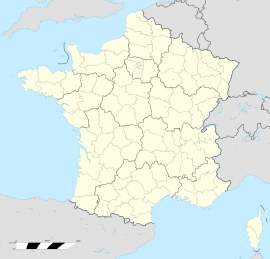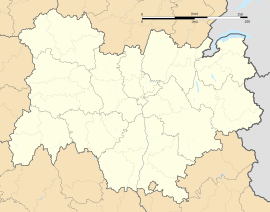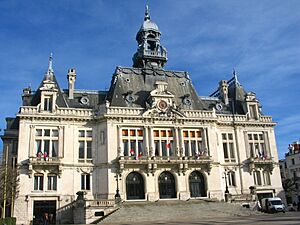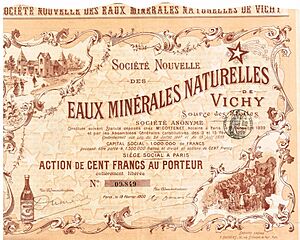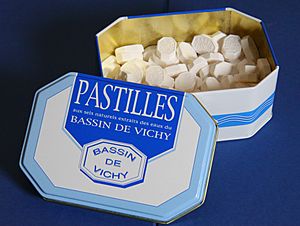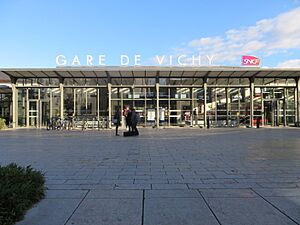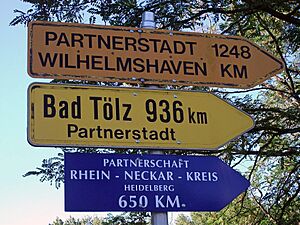Vichy facts for kids
Quick facts for kids
Vichy
Vichèi (Occitan)
|
||
|---|---|---|
|
Subprefecture and commune
|
||
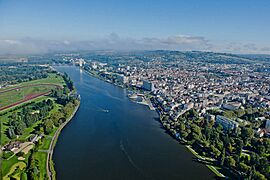
Aerial view of Vichy
|
||
|
||
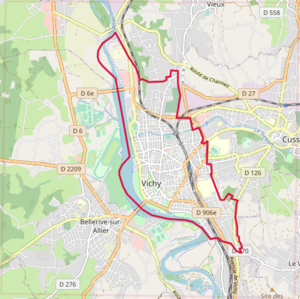 |
||
| Country | France | |
| Region | Auvergne-Rhône-Alpes | |
| Department | Allier | |
| Arrondissement | Vichy | |
| Canton | Vichy-1 & Vichy-2 | |
| Intercommunality | CA Vichy Communauté | |
| Area
1
|
5.85 km2 (2.26 sq mi) | |
| Population
(2021)
|
25,789 | |
| • Density | 4,408/km2 (11,418/sq mi) | |
| Time zone | UTC+01:00 (CET) | |
| • Summer (DST) | UTC+02:00 (CEST) | |
| INSEE/Postal code |
03310 /03200
|
|
| Elevation | 243–317 m (797–1,040 ft) (avg. 263 m or 863 ft) |
|
| Website | ville-vichy.fr | |
| UNESCO World Heritage Site | ||
| Part of | The Great Spa Towns of Europe | |
| Criteria | Cultural: (ii)(iii) | |
| Inscription | 2021 (45th Session) | |
| 1 French Land Register data, which excludes lakes, ponds, glaciers > 1 km2 (0.386 sq mi or 247 acres) and river estuaries. | ||
Vichy is a city in central France. It is located on the Allier river. Vichy is famous as a spa town and a resort town. During World War II, it became the capital of a special French government called Vichy France. In 2021, about 25,789 people lived in Vichy.
Vichy has been known for its mineral springs since ancient Roman times. By the late 1700s, it was a popular spot for French nobles and rich people. The city grew even more with help from Napoleon III. After the 1940 armistice in World War II, a government led by Philippe Pétain set up in Vichy. This government worked with Germany. Vichy was the unofficial capital of France for four years. After the war, the city did very well, but it started to decline in the 1960s.
In 2021, Vichy became a UNESCO World Heritage Site. It is part of the "Great Spa Towns of Europe" group. This is because of its famous baths and its buildings. These buildings show how popular spa towns were in Europe from the 1700s to the 1900s.
Contents
- Understanding the Name of Vichy
- Vichy's Location and Natural Features
- Vichy's Past: A Journey Through Time
- City Government and Leadership
- Vichy's Population Over Time
- Vichy's Economy and Businesses
- Famous People from Vichy
- Places of Worship in Vichy
- Getting Around Vichy: Transport Options
- Vichy's Sister Cities
- See also
Understanding the Name of Vichy
Vichy is the French way to say the city's name. In the Occitan language, it is called Vichèi. We are not sure where the name comes from. Some experts think it comes from an old Latin name, Vippiacus. This name might have referred to an important landowner named "Vippius" long ago.
- In English, you can say Vichy like "VISH-ee" or "VEE-shee".
- In French, it sounds like "vee-shee".
- The Occitan name Vichèi sounds like "vee-chay".
People from Vichy have special names. A female resident is called a Vichyssoise. A male resident is called a Vichyssois. The cold soup vichyssoise is also named after the city.
Vichy's Location and Natural Features
Vichy is located on the banks of the Allier river. The Allier river starts in the Massif Central plateau. This plateau is a few miles south of Vichy.
The Massif Central has a history of volcanic activity. You can still see signs of this today. While volcanoes there have been quiet for over 100 years, their past activity created Vichy's many hot springs.
Vichy's Special Mineral Springs
The famous mineral springs in Vichy are full of good things. They contain elements like lithium and fluorine. They are also high in sodium bicarbonate. The water temperatures vary greatly. For example, Antoine Spring is 73 degrees C, but Lafayette Spring is 14 degrees C.
There are about 289 springs in and around Vichy. These springs get their water from rain that soaks through old rocks.
Vichy's Climate
Vichy has an oceanic climate. This means it has mild temperatures. Heavy snows can block roads in the nearby Massif Central. But Vichy is lower, so its climate is less like a mountain. It gets a moderate amount of rain, about 779.5 mm each year.
| Town | Sunshine (hours/yr) |
Rain (mm/yr) |
Snow (days/yr) |
Storm (days/yr) |
Fog (days/yr) |
|---|---|---|---|---|---|
| National average | 1,973 | 770 | 14 | 22 | 40 |
| Vichy | 1,862 | 779.5 | 17.5 | 25.9 | 34.6 |
| Paris | 1,661 | 637 | 12 | 18 | 10 |
| Nice | 2,724 | 767 | 1 | 29 | 1 |
| Strasbourg | 1,693 | 665 | 29 | 29 | 56 |
| Brest | 1,605 | 1,211 | 7 | 12 | 75 |
| Climate data for Vichy (1981–2010 averages, extremes 1941−present) | |||||||||||||
|---|---|---|---|---|---|---|---|---|---|---|---|---|---|
| Month | Jan | Feb | Mar | Apr | May | Jun | Jul | Aug | Sep | Oct | Nov | Dec | Year |
| Record high °C (°F) | 19.2 (66.6) |
25.7 (78.3) |
27.0 (80.6) |
30.8 (87.4) |
33.5 (92.3) |
39.7 (103.5) |
41.2 (106.2) |
40.6 (105.1) |
36.4 (97.5) |
30.6 (87.1) |
26.2 (79.2) |
21.7 (71.1) |
41.2 (106.2) |
| Mean daily maximum °C (°F) | 7.4 (45.3) |
9.0 (48.2) |
13.0 (55.4) |
15.8 (60.4) |
20.0 (68.0) |
23.5 (74.3) |
26.4 (79.5) |
26.1 (79.0) |
22.2 (72.0) |
17.6 (63.7) |
11.2 (52.2) |
7.8 (46.0) |
16.7 (62.0) |
| Daily mean °C (°F) | 3.5 (38.3) |
4.4 (39.9) |
7.4 (45.3) |
9.8 (49.6) |
14.0 (57.2) |
17.4 (63.3) |
19.9 (67.8) |
19.5 (67.1) |
16.0 (60.8) |
12.4 (54.3) |
7.0 (44.6) |
4.1 (39.4) |
11.3 (52.3) |
| Mean daily minimum °C (°F) | −0.4 (31.3) |
−0.2 (31.6) |
1.9 (35.4) |
3.9 (39.0) |
8.1 (46.6) |
11.2 (52.2) |
13.3 (55.9) |
12.9 (55.2) |
9.8 (49.6) |
7.3 (45.1) |
2.8 (37.0) |
0.4 (32.7) |
5.9 (42.6) |
| Record low °C (°F) | −26.9 (−16.4) |
−24.0 (−11.2) |
−13.3 (8.1) |
−7.3 (18.9) |
−4.2 (24.4) |
−0.2 (31.6) |
3.7 (38.7) |
1.7 (35.1) |
−2.0 (28.4) |
−9.0 (15.8) |
−11.3 (11.7) |
−18.5 (−1.3) |
−26.9 (−16.4) |
| Average precipitation mm (inches) | 46.8 (1.84) |
39.8 (1.57) |
44.2 (1.74) |
69.3 (2.73) |
98.2 (3.87) |
78.2 (3.08) |
71.6 (2.82) |
74.2 (2.92) |
75.4 (2.97) |
68.0 (2.68) |
63.3 (2.49) |
50.5 (1.99) |
779.5 (30.7) |
| Average precipitation days | 10.0 | 8.9 | 9.0 | 10.8 | 12.2 | 9.5 | 8.1 | 8.8 | 8.7 | 10.4 | 10.3 | 10.0 | 116.7 |
| Average relative humidity (%) | 84 | 80 | 75 | 74 | 77 | 76 | 73 | 75 | 78 | 83 | 84 | 85 | 78.7 |
| Mean monthly sunshine hours | 78.1 | 94.8 | 153.7 | 175.4 | 203.4 | 225.0 | 248.9 | 238.3 | 183.5 | 128.1 | 76.7 | 55.9 | 1,861.7 |
| Source 1: Météo France | |||||||||||||
| Source 2: Infoclimat.fr (humidity, 1961–1990) | |||||||||||||
Vichy's Past: A Journey Through Time
Vichy in Roman Times
The first known town in Vichy was built by Roman legionaries. This happened in 52 BC. They were returning from a battle and found hot mineral springs by the Allier River. They named their town Aquae Calidae, which means "Hot Waters" in Latin. For the next 200 years, Vichy grew because people believed the springs had healing powers.
Vichy in the Middle Ages
In 1344, John II of France gave Vichy to Peter I, Duke of Bourbon. Later, in 1374, Louis II, Duke of Bourbon bought the rest of Vichy. This made Vichy part of the House of Bourbon. In 1410, a monastery was built with twelve monks. You can still see a building from this time above the Celestinian Spring.
In 1527, the House of Bourbon became part of the French Kingdom. By the late 1500s, the mineral baths were famous for their amazing healing powers. Rich and noble people came to Vichy for cures.
The Rise of Vichy's Thermal Baths
Marie de Rabutin-Chantal, marquise de Sévigné visited Vichy in 1676 and 1677. She wrote letters describing the baths, which made them even more popular. She said the Vichy waters cured the paralysis in her hands.
In 1761, King Louis XV's daughters, Adélaïde and Victoire, visited Vichy. They found the bath facilities uncomfortable. When they returned to Versailles, they asked their nephew Louis XVI to build better baths. These new, more luxurious baths were finished in 1787.
In 1799, Napoleon's mother, Laetitia Bonaparte, came to Vichy for treatment. During Napoleon's time, the Le Parc des Sources park was created. This was done by the Emperor's orders in 1812.
Under King Charles X, many more patients came to the springs. This led to bigger hydrotherapy buildings. Princess Marie-Thérèse-Charlotte expanded the Janson buildings, which were finished in 1830.
Vichy Becomes a Stylish Destination
By the 1800s, Vichy was a very fashionable place. Many famous people visited. But it was Napoleon III's visits between 1861 and 1866 that changed the city the most. He had dikes built along the Allier River. He also turned 13 hectares (about 32 acres) of old marshes into beautiful gardens.
New boulevards and streets were laid out. Chalets and pavilions were built for the emperor and his court. A large casino was built in 1865 for entertainment. Napoleon III also helped develop a small train station. This made the number of residents and visitors grow ten times in 50 years.
After the Second French Empire, the Belle Époque (Beautiful Era) brought another big building boom. In 1903, the Opera House, the Hall of Springs, and a large bathhouse were opened. The Parc des Sources was enclosed by a metal gallery in 1900. This gallery was 700 meters (about 2,300 feet) long.
Many private mansions with different architectural styles were built in the early 1900s. Vichy welcomed 40,000 visitors in 1900. This number grew to almost 100,000 before World War I. The spa life was at its peak in the 1930s. The success of the Vichy Baths led to even more expansions. The Art Nouveau-style Opera House hosted many famous international performers. Vichy became France's summer music capital. But World War I brought a sudden end to this growth.
Vichy France: A Wartime Capital
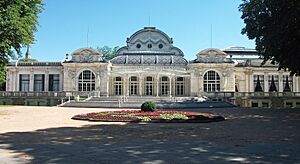
After France signed an armistice (peace agreement) with Germany on June 22, 1940, part of France was not occupied by the Germans. This area became known as the French State (État Français). Its capital was set up in Vichy on July 1. Vichy was chosen because it was relatively close to Paris. It also had the second-largest number of hotels in France. Plus, it had a modern telephone system that could connect to the whole world.
On July 1, the new government took over many hotels. Six hundred members of the French Parliament came to Vichy for a meeting. On July 9 and 10, in the Opera House, these members voted to end the Third Republic. The system of a republic was removed. The French State, led by Marshal Philippe Pétain, took its place. Only 80 of the 600 members of parliament disagreed.
From this date, Vichy was the unofficial capital of the French State for over four years. Paris was still the official capital, but the Vichy government never worked from there. This government is often called the Vichy Regime. People who supported this regime are called "Vichyste." This is different from "Vichyssois," which means people who live in Vichy.
Vichy: "Queen of the Spa Towns"
The 1950s and 1960s were a very showy time for Vichy. Famous people and royalty visited, like Prince Rainier III of Monaco. Many French clients from North Africa also came. They spent a lot of money. There were 13 cinemas, 8 dance halls, and 3 theaters. During this time, Vichy earned the title "Reine des villes d'eaux" (Queen of the Spa Towns).
From June to September, so many French-Algerian tourists arrived. It seemed like planes were constantly flying between Vichy and Algeria. The mayor, Pierre Coulon (1950–1967), decided to create Lake Allier (in 1963) and Omnisports Park (1963–68). These projects gave the city its modern look.
Vichy's Decline and Modern Comeback
The Algerian War of Independence (1950s-60s) led to decolonization. This again slowed down Vichy's success. The city had to deal with harder times. The new mayor, Jacques Lacarin (1967–1989), had to be very careful with money. This was because of the large debts from earlier, more prosperous times.
Today, Vichy is working to bring back its glory. Claude Malhuret, a former Minister of Human Rights, was mayor from 1989 to 2017. He helped start many projects. The city and its partners have done a lot of work to restore and modernize Vichy.
These projects include:
- Creating a large pedestrian zone in the city center.
- Modernizing and upgrading hotels.
- Rebuilding and restoring the thermal baths.
- Building a balneotherapy center for well-being.
- Improving the city's old buildings and heritage.
- Building a congress center inside the old Casino.
- Restoring the Opera House.
- Rebuilding the covered market, called "Grand Marché" (2006).
- Restoring the train station area (2009).
- Restoring "Rue de Paris," a main street (2010).
City Government and Leadership
Vichy is led by a mayor. The current mayor is Frédéric Aguilera. He started his term in 2020. Many different people have served as mayor throughout Vichy's history. They have come from various backgrounds, like doctors, pharmacists, and lawyers.
Vichy's Population Over Time
| Historical population | |||||||||||||||||||||||||||||||||||||||||||||||||||||||||||||||||||||||||||||||||||||||||||||||||||||||||||||||||||
|---|---|---|---|---|---|---|---|---|---|---|---|---|---|---|---|---|---|---|---|---|---|---|---|---|---|---|---|---|---|---|---|---|---|---|---|---|---|---|---|---|---|---|---|---|---|---|---|---|---|---|---|---|---|---|---|---|---|---|---|---|---|---|---|---|---|---|---|---|---|---|---|---|---|---|---|---|---|---|---|---|---|---|---|---|---|---|---|---|---|---|---|---|---|---|---|---|---|---|---|---|---|---|---|---|---|---|---|---|---|---|---|---|---|---|---|
|
|
||||||||||||||||||||||||||||||||||||||||||||||||||||||||||||||||||||||||||||||||||||||||||||||||||||||||||||||||||
| Source: EHESS and INSEE (1968-2017) | |||||||||||||||||||||||||||||||||||||||||||||||||||||||||||||||||||||||||||||||||||||||||||||||||||||||||||||||||||
Vichy's population has changed a lot over the years. In 1793, there were 1,763 people. By 1968, the population reached its highest point with 33,506 people. Since then, the population has slowly decreased. In 2017, there were 24,166 people living in Vichy.
Vichy's Economy and Businesses
Vichy is famous for its thermal cures. Its waters come from springs like Vichy Celestins and Vichy Saint-Yorre.
Vichy Pastilles are octagon-shaped candies. They are made from soda found in the spring waters.
The health and beauty company L'Oréal has laboratories in Vichy. They make products under the Vichy brand. This helps make the city's name known worldwide.
Unlike nearby industrial towns, Vichy's economy focuses on services. Companies like the Compagnie de Vichy are growing the health and well-being sector. This helps make up for the decline in medical hydrotherapy. The local market, open on Sundays, attracts shoppers from many miles away.
Some important local companies have closed. However, new companies are creating jobs. For example, the NSE electronics company and the Satel call center company. The internet travel company Karavel also opened a new call center in 2005.
The two biggest employers in Vichy are public. These are the hospital, with 1,120 employees, and the town hall, with 500 employees.
Since 1989, Vichy has been one of seven sites for the European Total Quality Institute.
The Pôle Universitaire de Vichy is a university center. It was started in the mid-1990s. This center is an important part of the economy. It is 9,000 square meters (about 97,000 square feet) and has 600 students. They study subjects like biotechnology, international trade, and languages.
The CAVILAM – Alliance Française is a language learning center. It welcomes students from many countries who want to learn French. It was created in 1964. After the Covid lockdown, the center started offering online courses.
The Palace of the Congresses hosts conferences. It has two main rooms and fifteen other rooms. About 25,000 visitors come each year for conferences. These events now play a big economic role. This role was once held by the hydrotherapy industry. Today, only about 12,000 patients visit for hydrotherapy each year. The hydrotherapy business is changing. It is now focusing less on strict medical treatments. It is also adapting to shorter patient stays.
New Building Projects in Vichy
Local authorities are working on many building projects. These will greatly change Vichy in the coming years. A new Hotel of the Community of Agglomeration opened in 2005. The market hall "Le Grand Marché" was fully restored in 2006.
Other projects include:
- A 12,000 square meter (about 129,000 square feet) mother-child center at the hospital.
- Restoring the spa façade to its original 1862 style.
- Turning the spa into a multi-use center.
- Creating parks with fountains where parking lots used to be.
- Building an enterprise center to create 800 jobs (opened in 2008).
- Building a new aquatic stadium with five pools (opened in 2008).
- A new motorway connection (opened in 2015).
Famous People from Vichy
- Valery Larbaud (1881–1957), a well-known writer.
- Albert Londres (1884–1932), a famous journalist.
- Guy Ligier (1930–2015), a racing driver who started Équipe Ligier.
- Raël (born 1946), a religious leader who founded the Raëlian Religious Movement.
- Wilfried Moimbe (born 1988), a professional footballer.
Places of Worship in Vichy
Vichy has many different places for people to practice their faith. You can find various Christian churches, including Orthodox, Catholic, and Protestant churches. There are also places for followers of Judaism, Islam, Buddhism, and other faiths.
- Catholicism:
- Presbytère Saint-Louis Saint-Blaise de Vichy at 33 Rue Sainte-Cécile.
- Presbytère Sainte Jeanne d'Arc at 2 Rue Jeanne d'Arc.
- Russian Orthodox Church: The nearby Château de Saint-Hubert in Chavenon.
- Calvinism: Église reformée located at 9 Rue de l'Intendance.
- Lutheranism: Église Saint-Blaise de Vichy located on the Rue de l'Église.
- Judaism: The Synagogue of Vichy located at 2 Bis Rue Maréchal Foch.
- Islam: The Mosquée al-Rahma located at 51 Allée des Ailes.
- Buddhism: The nearby Pagode Phap Vuong in Noyant-d'Allier.
Getting Around Vichy: Transport Options
Road Access to Vichy
You can reach Vichy by several roads. Departmental road 2209 is a main route. It comes from towns like Gannat or Varennes-sur-Allier. Other important roads include the D906e from Thiers and the D1093 from Randan.
Vichy is about 20 kilometers (12 miles) from the A719 autoroute. It is also about 35 kilometers (22 miles) from the A89 autoroute. The A719 autoroute connects Vichy to the A71, which goes to Clermont-Ferrand. This connection opened in January 2015.
In 2014, only regional two-lane highways passed through Vichy's city area. The D2209 is a main road for large trucks. Other important routes include:
- The D906e, from the south (like Abrest and Thiers).
- The D1093, from the southwest (like Randan and Clermont-Ferrand).
- The D984, from the west-southwest (like Bellerive-sur-Allier).
- The D6, from the northwest (like Charmeil and Saint-Pourçain-sur-Sioule).
The D67 is a loop road north of the city. It helps reduce traffic jams.
Train Travel to Vichy
Vichy has train services that connect it to other cities.
- Intercités trains go to Paris (Bercy station) and Clermont-Ferrand. You need to book tickets for these trains.
- TER trains connect Vichy to places like Moulins, Lyon (Part-Dieu and Perrache stations), and Clermont-Ferrand.
Public Transport in Vichy
MobiVie is the public transport system for Vichy and nearby towns. It has eight bus lines as of 2022.
"Mobival" is a special on-call transport service. It helps people in areas not served by the MobiVie network. This service started in 2004 and has ten lines.
Air Travel to Vichy
Vichy is 5 kilometers (3 miles) from Vichy — Charmeil Airport. For larger flights, the Clermont-Ferrand Auvergne Airport is 55 kilometers (34 miles) away.
Vichy's Sister Cities
Vichy has "sister city" relationships with several towns around the world. This means they share cultural and educational ties. Vichy is twinned with:
 Bad Tölz, Germany
Bad Tölz, Germany Dunfermline, Scotland, United Kingdom
Dunfermline, Scotland, United Kingdom Rhein-Neckar (district), Germany
Rhein-Neckar (district), Germany San Giuliano Terme, Italy
San Giuliano Terme, Italy Wilhelmshaven, Germany
Wilhelmshaven, Germany
See also
 In Spanish: Vichy para niños
In Spanish: Vichy para niños



